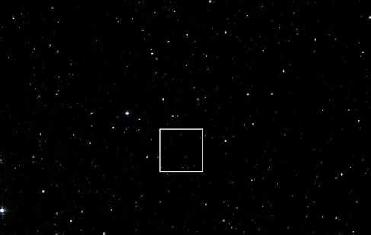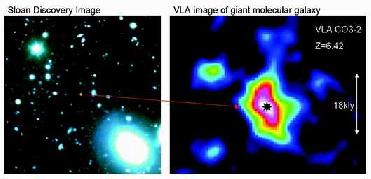
GRB 080607 exploded June 7, 2008, in the constellation Coma Berenices. The box indicates the sky area shown in the Swift image. Credit: DSS/STScI/AURA
WASHINGTON (BNS): Astronomers have identified gas molecules in the host galaxy of a gamma-ray burst. Combining data on explosion, designated GRB 080607, from NASA's Swift satellite, the W M Keck Observatory in Hawaii, and other facilities, astronomers arrived at this conclusion.
Professor Xavier Prochaska of University of California, Santa Cruz, said that this burst gave an opportunity to 'taste' the star-forming gas in a young galaxy more than 11 billion light-years away. �The finding provides insight into star formation when the universe was about one-sixth its present age,� he said.
Gamma-ray bursts, the universe's most luminous explosions, create bright afterglows. Their light encodes information about the gas and dust it encounters on its way to Earth.
�We clearly see absorption from two molecular gases: hydrogen and carbon monoxide. Those are gases we associate with star-forming regions in our own galaxy,� Prochaska said. The team believes that the burst exploded behind a thick molecular cloud similar to those that spawn stars in our galaxy today.
NASA said that Gamma rays from GRB 080607 triggered Swift's Burst Alert Telescope shortly after 2:07 a.m. EDT on June 7, 2008. Swift calculated the burst's position, beamed the location to a network of observatories, and turned to study the afterglow, it said.
According to NASA, on that night, University of California, Berkeley, professor Joshua Bloom and graduate students Daniel Perley and Adam Miller were using the Low Resolution Imaging Spectrometer on the 10m Keck I Telescope in Hawaii.
�Because afterglows fade rapidly, we really had to scramble when we received the alert. But in less than 15 minutes, we were on target and collecting data,� Perley said.
NASA said that the molecular cloud in the burst's host galaxy was so dense, less than one per cent of the afterglow's light was able to penetrate it. �Intrinsically, this afterglow is the second brightest ever seen. That's the only reason we were able to observe it at all,� Prochaska explained.
Team member Yaron Sheffer of the University of Toledo, Ohio, said that screening from thick molecular clouds provides a natural explanation for so-called �dark bursts,� which lack associated afterglows. �We suspect that previous events like GRB 080607 were just too faint to be observed,� Sheffer said.
The premier space agency said that most gamma-ray bursts occur when massive stars run out of nuclear fuel. As the star's core collapses into a black hole or neutron star, gas jets punch through the star and into space. Bright afterglows occur as the jets heat gas that was previously shed by the star. Because a massive star lives only a few tens of millions of years, it never drifts far from its natal cloud, NASA said.
 Next Article
Next Article












The Indian Air Force, in its flight trials evaluation report submitted before the Defence Ministry l..
view articleAn insight into the Medium Multi-Role Combat Aircraft competition...
view articleSky enthusiasts can now spot the International Space Station (ISS) commanded by Indian-American astr..
view article